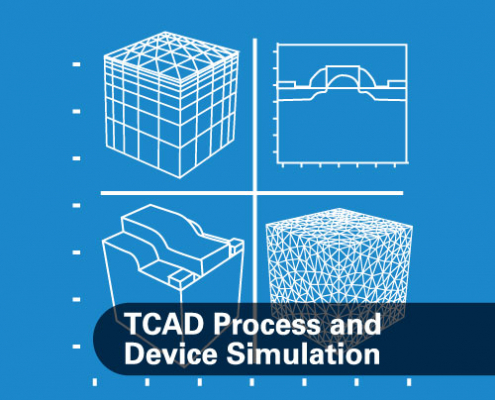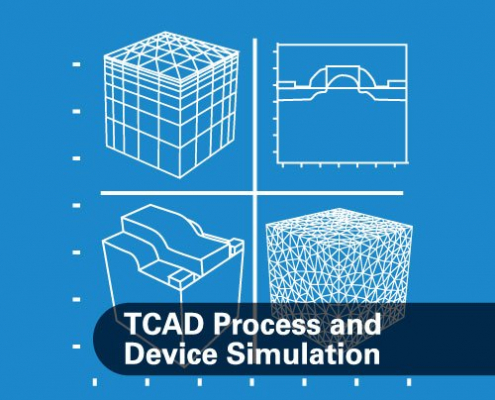
Silvaco Exhibits and Presents Invited Paper on Atomistic Simulation at IEDM 2019
The IEEE International Electron Devices Meeting (IEDM) is the world’s preeminent forum for reporting technological breakthroughs in the areas of semiconductor and electronic device technology, design, manufacturing, physics, and modeling. It is the flagship conference forNanometer-scale CMOS transistor technology, advanced memory, displays, sensors, MEMS devices
Novel quantum and nano-scale devices and phenomenology
Optoelectronics, devices for power and energy harvesting, high-speed devices
Process technology and device modeling and simulation

극저온에서의 실리콘 소자 시뮬레이션
2019년 11월 8일 | 3:00am-3:30am (한국 시각)
4K~100K 온도에서 실리콘 소자의 동작 시뮬레이션에 drift-diffusion 방법을 사용할 때 발생하는 문제에 대해 논의합니다.

SiC 및 기타 와이드 밴드갭 물질: 공정부터 소자 시뮬레이션까지
2019년 11월 1일 | 3:00am-3:30am (한국 시각)
실바코의 TCAD 툴을 소개하고, wide bandgap 물질에 대한 공정 및 소자 시뮬레이션 기능을 살펴봅니다.

How TCAD Can Optimize Power Electronics
The power electronics (PE) market is growing rapidly, driven by the accelerating demand of EV and HEV vehicles. Power devices lend themselves to design and manufacturing innovations at the transistor-level to improve device performance and reduce development and production costs. Silicon-carbide (SiC), gallium-nitride (GaN), and other wide bandgap materials have started to replace silicon in high-voltage power devices.
 /wp-content/uploads/2019/11/silvaco-logo.png
0
0
Erick Castellon
/wp-content/uploads/2019/11/silvaco-logo.png
Erick Castellon2019-10-01 17:25:482023-03-13 01:00:14TCAD
/wp-content/uploads/2019/11/silvaco-logo.png
0
0
Erick Castellon
/wp-content/uploads/2019/11/silvaco-logo.png
Erick Castellon2019-10-01 17:25:482023-03-13 01:00:14TCAD
The Need for Advanced Wide Bandgap Power Electronics
PowerAmerica’s strategic roadmap for next generation wide bandgap (WBG) power electronics (PE) came out earlier this year. The public version of the roadmap includes a background/introduction and market forecast pertaining to silicon carbide (SiC) and gallium nitride (GaN) PE. I learned a great deal about SiC & GaN PE in this roadmap and I have copied the relevant sections below.

3D TCAD Simulation for Power Devices
y first IC design back in 1978 was a DRAM and it ran on 12V, 5V and -5V, but then my second DRAM was using only a 5V supply. Today we see SOCs running under a 1V supply voltage, but there is a totally different market for power devices that are at the other end of the voltage spectrum and they handle switching ranges from 12V – 250V. To learn more about power devices and how the process and device modeling is done, I read a Silvaco publication entitled Advanced Process and Device 3D TCAD Simulation of Split-Gate Trench UMOSFET.

Where Circuit Simulation Model Files Come From
I started out my engineering career by doing transistor-level circuit design and we used a proprietary SPICE circuit simulator. One thing that I quickly realized was that the accuracy of my circuit simulations depended entirely on the model files and parasitics. Here we are 40 years later and the accuracy of SPICE circuit simulations still depend on the model files and parasitics, but with the added task of using 3D field solvers to get accurate parasitic values, and even the use of 3D TCAD tools to model the complex physics of nm IC designs using FinFET transistors.

230 Papers on Power Device Simulations using Silvaco TCAD
A quick search of the IEEE Xplore online library gives a list of more than 230 published technical articles on Power Device Simulation using Silvaco TCAD. Here are some recent papers with the authors’ abstracts that cover silicon-carbide (SiC) and Junction-Less Double Gate MOSFET devices. Any mention of ‘we’ or ‘our’ refers to the paper’s authors:

Advanced Materials and New Architectures for AI Applications
Over the past 50 years in our industry, there have been three invariant principles:Moore’s Law drives the pace of Si technology scaling
system memory utilizes MOS devices (for SRAM and DRAM)
computation relies upon the “von Neumann” architecture
